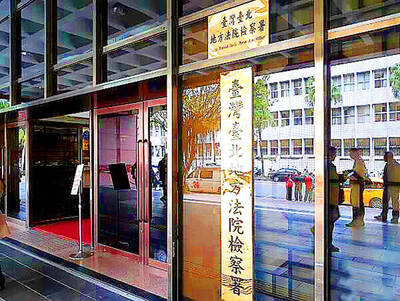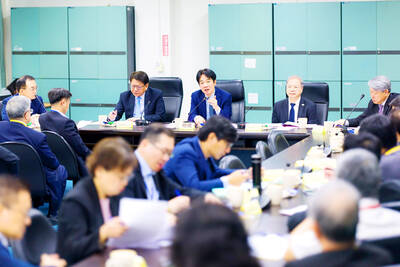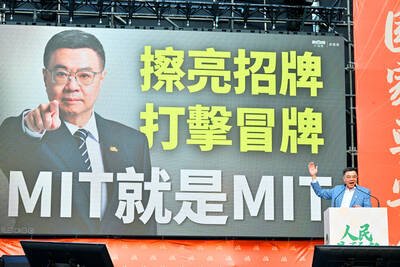The public and private sectors are to spend NT$200 billion (US$6.6 billion) on measures aimed at reducing air pollution, with a goal of lowering levels of PM2.5 — fine particulate matter with a diameter of 2.5 micrometers or less — by 18 percent by 2019.
The government said that NT$36.51 billion has been earmarked to target lowering PM2.5 levels from 22 micrometers per cubic meter to 18 micrometers per cubic meter by 2019 and to reduce the number of “air pollution red alerts” by 47 percent, or from 997 per year to 528 per year.
State-run Taiwan Power Co (Taipower, 台電) is to invest NT$10.11 billion to reduce power plant emissions by 2019 and another NT$22.15 billion afterward, while the private sector is expected to invest between NT$168.4 billion and NT$247.7 billion in air pollution controls.

Photo: Peter Lo, Taipei Times
The Cabinet has established 14 pollution control measures, including improving power generation efficiency; phasing out aging and energy-intensive vehicles and steam generators; reducing construction emissions, cooking emissions and dust emissions; curbing the burning of biomass and religious offerings; and promoting public transport and electric vehicles.
“The public does not feel the effects of the government’s pollution control measures, because there are too many sources of pollution and a single control measure cannot bring about much improvement,” Premier Lin Chuan (林全) said.
“The 14 short and medium-term measures — proposed by different ministries on a practical basis — are to engage air pollution in 14 battlegrounds to achieve tangible results in the short term,” Lin said.
As 10 to 40 percent of pollutants in Taiwan originate overseas, the government is to negotiate with neighboring nations to seek cooperation on regional pollution controls, Lin said.
Environmental Protection Administration (EPA) Minister Lee Ying-yuan (李應元) said the agency plans to phase out more than 1 million two-stroke scooters and 80,000 aging diesel trucks, while refitting 38,000 diesel trucks with diesel particulate filters in three years to reduce traffic emissions, which produce 30 to 37 percent of the total air pollution.
Stricter emissions controls would be implemented to reduce industrial emissions, which account for 27 to 31 percent of the total air pollution, with the EPA and the Ministry of Economic Affairs to subsidize the replacement of 6,000 inefficient steam boilers nationwide, Lee said.
Taipower has upgraded a coal-fired power plant in New Taipei City’s Linkou District (林口) with advanced ultra-supercritical power generation technology, which could lower the plant’s emissions to levels of natural-gas-powered plants, with Taipower planning to upgrade its power generation facilities nationwide, Lee said.
Asked if the requirements, coupled with plans to phase out nuclear power by 2025, would cause power shortages or investment instability, Lin said the government would ensure a stable supply of electricity and water to sustain economic development, adding that environmental protection is necessary even if it means more restrictions.

INVESTIGATION: The case is the latest instance of a DPP figure being implicated in an espionage network accused of allegedly leaking information to Chinese intelligence Democratic Progressive Party (DPP) member Ho Jen-chieh (何仁傑) was detained and held incommunicado yesterday on suspicion of spying for China during his tenure as assistant to then-minister of foreign affairs Joseph Wu (吳釗燮). The Taipei District Prosecutors’ Office said Ho was implicated during its investigation into alleged spying activities by former Presidential Office consultant Wu Shang-yu (吳尚雨). Prosecutors said there is reason to believe Ho breached the National Security Act (國家安全法) by leaking classified Ministry of Foreign Affairs information to Chinese intelligence. Following interrogation, prosecutors petitioned the Taipei District Court to detain Ho, citing concerns over potential collusion or tampering of evidence. The

Seventy percent of middle and elementary schools now conduct English classes entirely in English, the Ministry of Education said, as it encourages schools nationwide to adopt this practice Minister of Education (MOE) Cheng Ying-yao (鄭英耀) is scheduled to present a report on the government’s bilingual education policy to the Legislative Yuan’s Education and Culture Committee today. The report would outline strategies aimed at expanding access to education, reducing regional disparities and improving talent cultivation. Implementation of bilingual education policies has varied across local governments, occasionally drawing public criticism. For example, some schools have required teachers of non-English subjects to pass English proficiency

NEGOTIATIONS: The US response to the countermeasures and plans Taiwan presented has been positive, including boosting procurement and investment, the president said Taiwan is included in the first group for trade negotiations with the US, President William Lai (賴清德) said yesterday, as he seeks to shield Taiwanese exporters from a 32 percent tariff. In Washington, US Trade Representative Jamieson Greer said in an interview on Fox News on Thursday that he would speak to his Taiwanese and Israeli counterparts yesterday about tariffs after holding a long discussion with the Vietnamese earlier. US President Donald Trump on Wednesday postponed punishing levies on multiple trade partners, including Taiwan, for three months after trillions of US dollars were wiped off global markets. He has maintained a 10 percent

TRADE: The premier pledged safeguards on ‘Made in Taiwan’ labeling, anti-dumping measures and stricter export controls to strengthen its position in trade talks Products labeled “made in Taiwan” must be genuinely made in Taiwan, Premier Cho Jung-tai (卓榮泰) said yesterday, vowing to enforce strict safeguards against “origin laundering” and initiate anti-dumping investigations to prevent China dumping its products in Taiwan. Cho made the remarks in a discussion session with representatives from industries in Kaohsiung. In response to the US government’s recent announcement of “reciprocal” tariffs on its trading partners, President William Lai (賴清德) and Cho last week began a series of consultations with industry leaders nationwide to gather feedback and address concerns. Taiwanese and US officials held a videoconference on Friday evening to discuss the